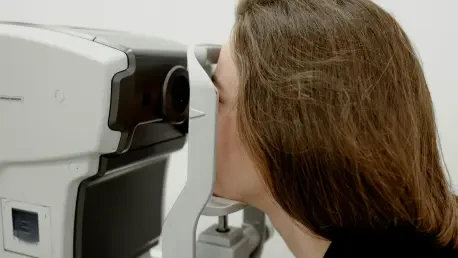Imagine a world where the gradual loss of vision due to age-related conditions no longer means a life of diminished independence, where innovative treatments can restore the ability to read, drive, or simply see a loved one’s face clearly. In Canada, this vision is becoming a reality with groundbreaking advancements in ophthalmic care. A pivotal development leading this charge is the introduction of a novel device designed to tackle dry age-related macular degeneration (AMD), a condition affecting countless individuals and often leading to severe visual impairment. Alongside this, a wave of approvals and partnerships in the eye care sector is reshaping the landscape, offering new hope through cutting-edge technology and enhanced accessibility. These strides reflect a broader commitment to addressing unmet needs in vision health, setting the stage for a transformative era in how eye conditions are managed and treated across the nation.
Innovations in Treatment Options
Breakthrough Device for Dry AMD
A significant milestone in Canadian eye care is the recent approval of a pioneering device by Health Canada, specifically designed to address dry AMD, a condition that has long lacked effective therapeutic options. This non-invasive system delivers low-dose microcurrent stimulation through closed eyelids in sessions lasting just over 30 minutes. By targeting retinal cells, the technology aims to enhance mitochondrial function, reduce inflammation, and increase ATP production, ultimately improving visual capabilities. Already available in over 150 clinics nationwide, the device has facilitated thousands of treatments, with clinical trials demonstrating measurable gains in visual acuity and contrast sensitivity. Industry leaders and ophthalmologists alike have hailed this as a game-changer, providing a lifeline to patients who previously faced limited prospects for managing their condition, thereby significantly enhancing their quality of life.
The impact of this device extends beyond clinical outcomes, as it represents a shift toward non-invasive solutions in eye care. Patients undergoing treatment have reported noticeable improvements in daily activities, such as reading small print or recognizing details in low-light conditions. The accessibility of this technology across numerous clinics ensures that more individuals can benefit without the need for invasive procedures or prolonged recovery times. Furthermore, the endorsement from eye care specialists underscores the potential for this approach to become a standard in managing dry AMD. As research continues to validate its efficacy, there is growing optimism that such innovations could pave the way for similar advancements in treating other degenerative eye conditions, marking a new chapter in how vision impairment is approached in Canada.
Advancements in Retinal Disease Management
Parallel to the introduction of the dry AMD device, Canada has seen remarkable progress in treatments for various retinal diseases through recent regulatory approvals. A notable development includes the approval of a biosimilar for retinal conditions, offering a cost-effective alternative to existing therapies. This marks a significant step toward broadening access to essential treatments for patients suffering from vision-threatening disorders. Additionally, a new partnership between pharmaceutical companies aims to market and distribute another biosimilar across multiple regions, further driving down costs and improving availability. These efforts highlight a concerted push within the industry to address affordability while maintaining high standards of care for complex eye conditions.
Another key advancement is the public funding of an innovative injection treatment for macular edema secondary to retinal vein occlusion in certain provinces. This funding ensures that patients can access cutting-edge therapies without the burden of prohibitive costs, a move that has been widely praised by healthcare advocates. The integration of such treatments into public health systems reflects a growing recognition of the importance of equitable access to advanced medical solutions. As these therapies become more widely available, they are expected to significantly reduce the progression of retinal diseases, preserving vision for many who might otherwise face severe impairment. This trend of combining innovation with accessibility sets a promising precedent for future developments in the field of ophthalmic care.
Enhancing Access and Affordability
Cutting-Edge Solutions for Cataract Patients
In the realm of cataract treatment, Canada has welcomed the approval of an advanced intraocular lens (IOL) that promises superior visual outcomes for patients undergoing surgery. This state-of-the-art lens incorporates technology designed to optimize light utilization and minimize scatter, resulting in clearer vision post-procedure. Such advancements are crucial for individuals seeking to regain full visual function after cataract removal, a common procedure among aging populations. The introduction of this lens underscores the ongoing commitment to improving surgical outcomes through technological innovation, ensuring that patients benefit from the latest in optical science as part of their recovery journey.
The broader implications of this approval are evident in the potential for enhanced patient satisfaction and reduced dependency on corrective eyewear following surgery. Eye care professionals have noted that this lens technology addresses longstanding challenges in achieving optimal visual clarity, particularly in varying light conditions. By integrating such innovations into clinical practice, the field of cataract surgery is evolving to meet the diverse needs of patients, from those requiring basic vision restoration to others seeking premium visual performance. This development not only elevates the standard of care but also positions Canada as a leader in adopting cutting-edge solutions for common yet impactful eye conditions, fostering greater confidence among patients and practitioners alike.
Strategic Partnerships and Public Funding Initiatives
Equally important to technological innovation is the focus on making treatments more accessible through strategic collaborations and funding mechanisms. A recent agreement between major pharmaceutical entities to commercialize cost-effective biosimilars exemplifies how partnerships can expand the reach of vital eye care solutions. These collaborations aim to streamline distribution channels, ensuring that advanced therapies are available even in underserved regions. Such initiatives are pivotal in addressing disparities in access to care, allowing a broader segment of the population to benefit from the latest medical advancements without financial strain.
In addition, the inclusion of certain advanced treatments on public medication lists in specific provinces has marked a significant step forward in affordability. This move alleviates the economic burden on patients who require ongoing therapy for chronic eye conditions, ensuring that financial constraints do not hinder access to life-changing care. The combined effect of these partnerships and funding efforts reflects a holistic approach to eye health, where innovation is matched by a commitment to equity. Looking back, these efforts demonstrate a clear intent to transform the landscape of vision care, setting a foundation for sustained progress and inspiring confidence in the future of ophthalmic treatment accessibility across Canada.









